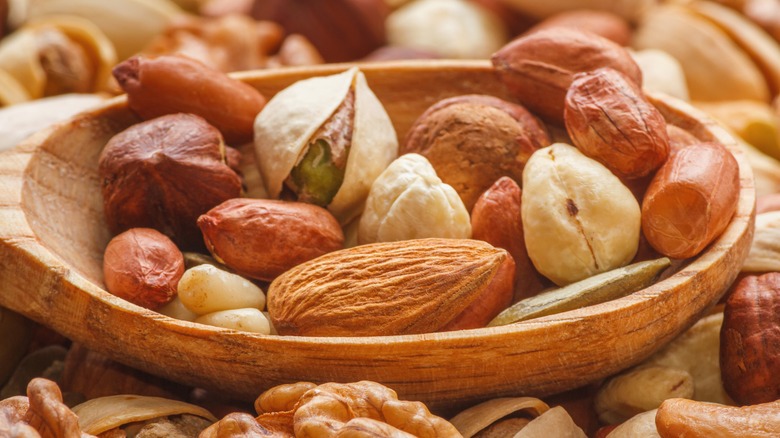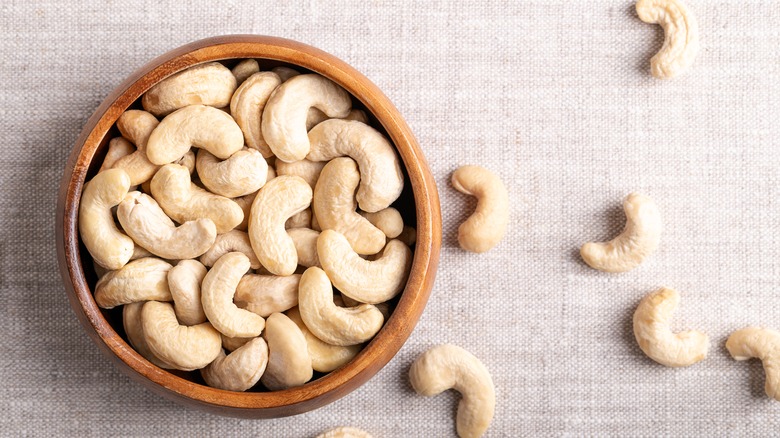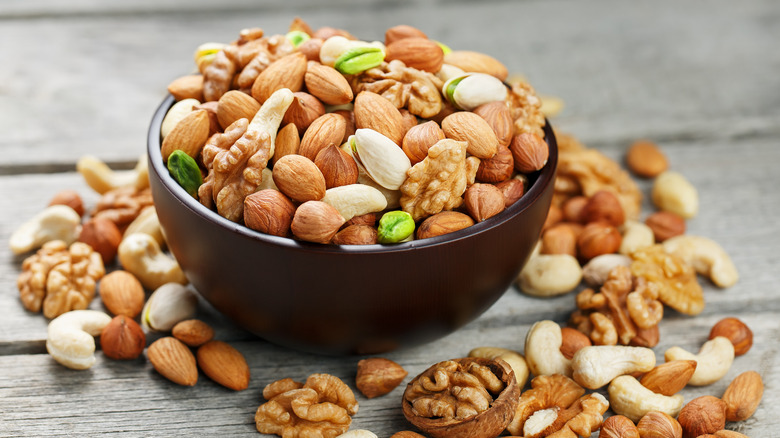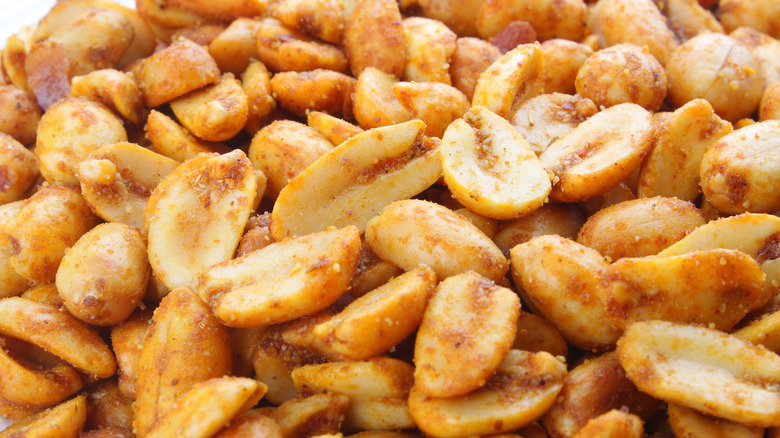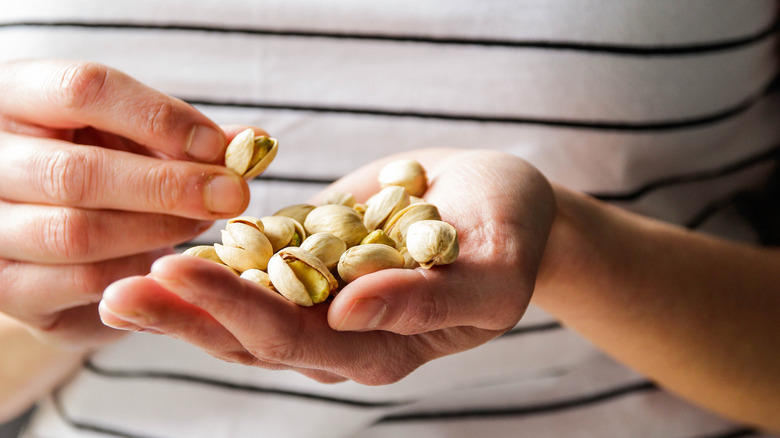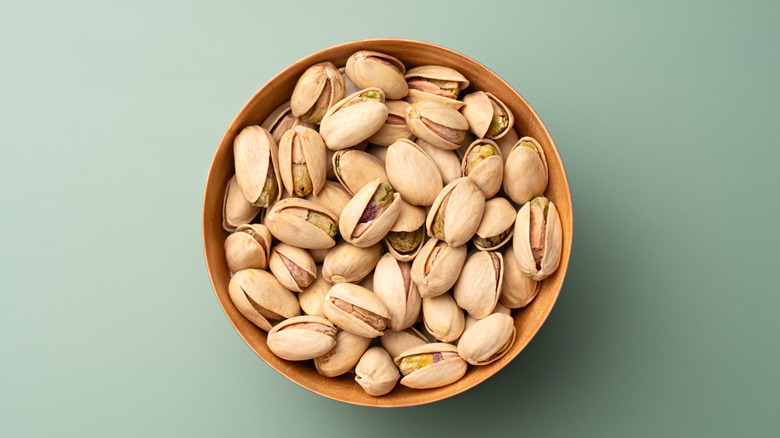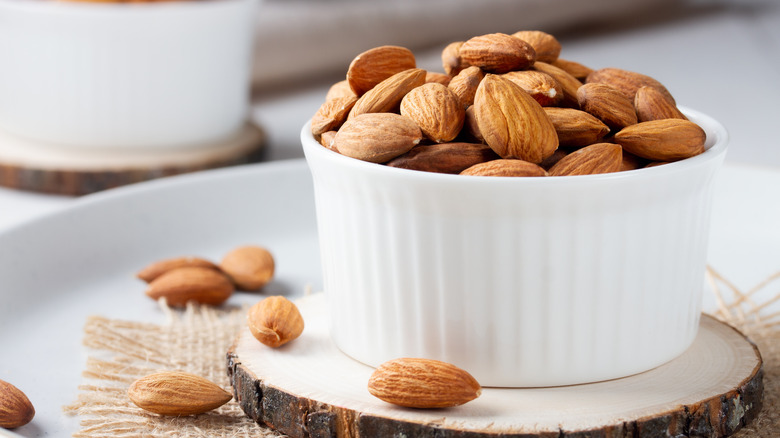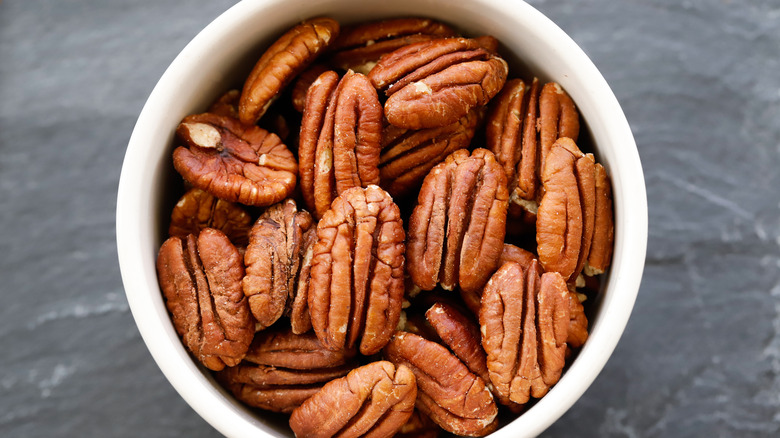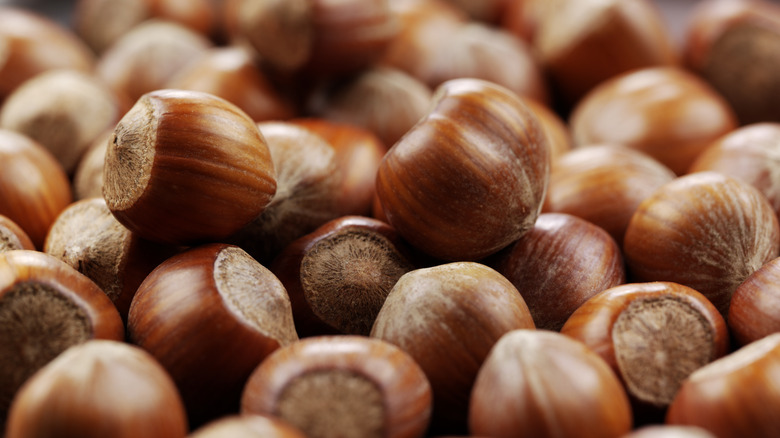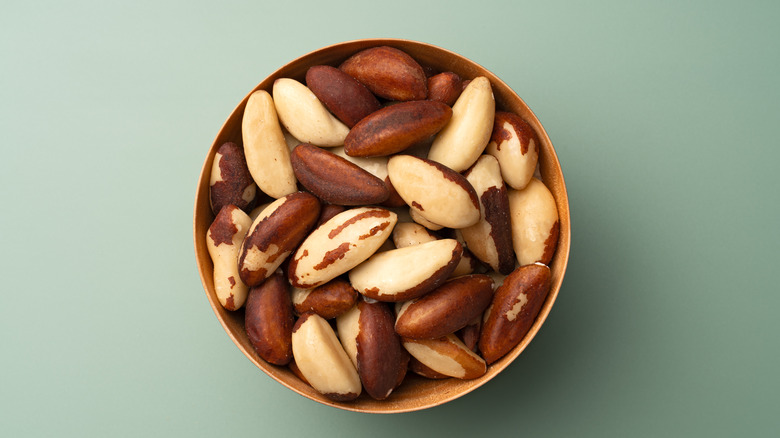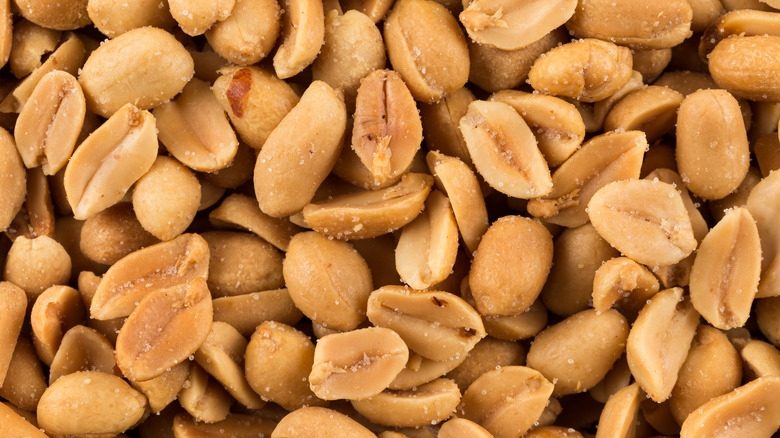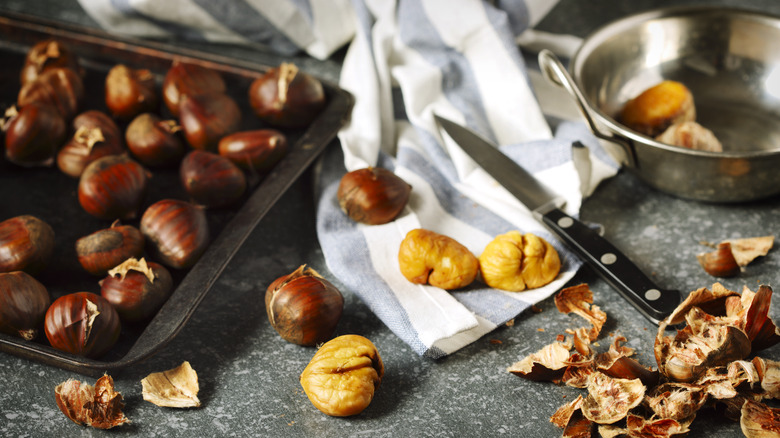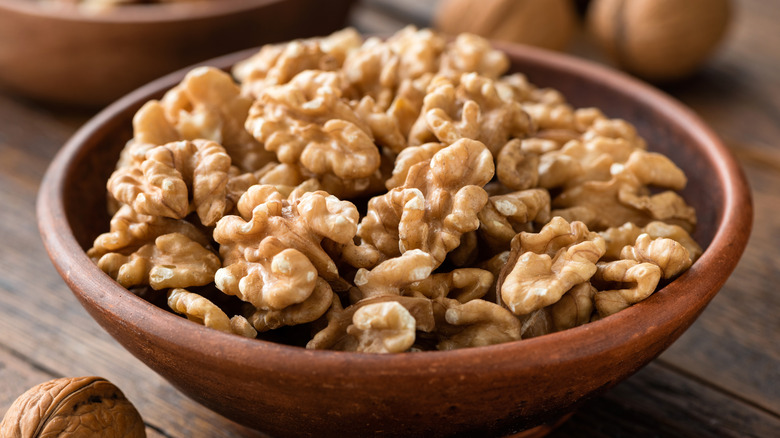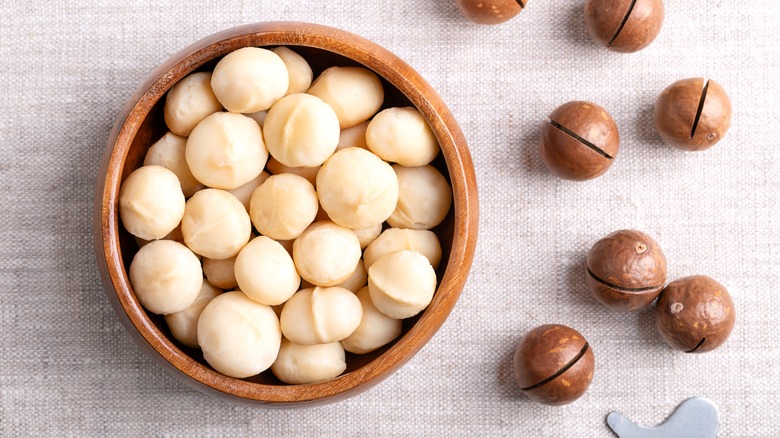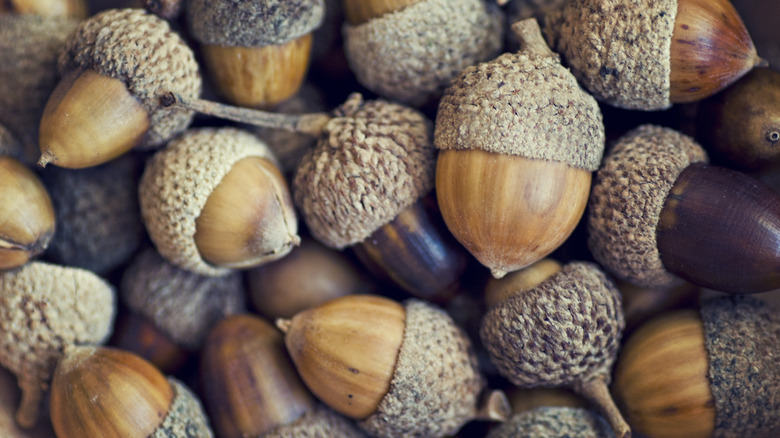6 Nuts To Stop Eating And 8 To Choose Instead
We may receive a commission on purchases made from links.
You've probably heard conflicting information about nuts. Some say they are the best thing to reach for when you want a healthy snack that's filled with protein, and nuts can be found in a bevy of so-called healthy foods, like trail mix. Meanwhile, others say to stay away from nuts, because it's all too easy to overdo it and eat too many. There's such a thing as too much of a good thing — and when it comes to fat-filled nuts, that health-conscious snack can quickly turn less-than-ideal. Still others will tell you to stay away from nuts because the farming practices necessary for some varieties are killing the planet.
So which is it? Are nuts good, bad, or somewhere in between? In truth, it all comes down to the varieties of nuts you're consuming. Here are nuts to reconsider eating or to eat in lesser quantities, and some nuts to reach for every time you're at the grocery store.
Stop eating: Cashews
The cashew is admittedly delicious and very versatile. Beyond using it in both sweet and savory dishes, you can use it to make butter, milk, or even cheese. However, for all of the goodness cashews offers, even health benefits like healthy fats, protein, and fiber, they're not exactly the perfect nut.
Cashews are particularly high in saturated fat compared to other nuts (twice the amount that you'll find in an almond). Too much saturated fat can increase your cholesterol. Beyond the saturated fat, cashews also come with human rights-related concerns. Cashews are largely grown and processed in some of the poorest countries in the world, and the process is both labor intensive and potentially dangerous to workers. For example, when shelling cashews, cashews produce a corrosive substances that causes burns, and not all workers have access to protective measures. Workers may be paid by output rather than hour. In some cases, patients at drug rehabilitation facilities are used as forced labor to process cashews.
In short, if you're going to eat cashews, do a little research to uncover where they come from and how they're making their way to your grocery store. Then, just watch the saturated fat.
Stop eating: Roasted nuts
Roasted nuts, whether they're dry-roasted or honey-roasted, no matter what type of nuts they are, often come with a few extra ingredients: salt and/or sugar. For example, Fisher's oven-roasted almonds come with 170 calories, 15 grams of fat, and 110 milligrams of sodium per serving. Meanwhile, Blue Diamond's whole, raw almonds contain no sodium at all, as well as slightly less fat and calories. Likewise, while Blue Diamond's whole, raw almonds only contain 1 gram of sugar, equating to 0% of your daily recommended intake, Blue Diamond's honey roasted almonds come with 5 grams of total sugar, for nearly 10% of your daily recommended intake.
If you like the roasted flavor of roasted nuts, but want to avoid extra salt and sugar, you can dry fry or oven toast nuts at home, easily. To dry fry any nut variety, add your nuts to a warm skillet on your stovetop and let them toast for just several minutes, moving the nuts to avoid burning. To oven toast nuts, spread them in an even layer on a baking sheet and pop them in the oven for around 10 minutes. You'll still need to shake the nuts around a time or two to prevent burning.
Stop eating: Salted or flavored nuts
It's not just roasted nuts that come with extra salt and sugar. Salted and flavored nuts likewise bring extra sodium and added sugars to the party. Again, Blue Diamond's whole, raw almonds contain no sodium at all. In contrast, the brand's smokehouse almonds and Korean barbecue almonds contain 7% and 6% of your daily recommended sodium, respectively. Similarly, raw peanuts contain no sodium, while Snak Club's ranch-flavored peanuts contain 16% of your daily recommended sodium, and Nature's Eats' garlic Parm peanuts contain 10% of your daily recommended sodium. Beyond the general higher sodium content, it's also worth noting that, if you're eating salted or flavored nuts while drinking alcohol (a popular pairing at bars and parties), you're more likely to drink more and faster, due to the extra salt content.
You don't have to give up on flavored nuts entirely, though. If you're already roasting your nuts at home, add in some sodium-free flavorings. Reach for options likely already in your spice rack, such as paprika, cayenne pepper, or cinnamon.
Stop eating: Excess nuts
Regardless of the type of nut you're eating, experts recommend eating nuts in moderation, in order to get the most health benefits possible. A general serving of nuts, regardless of variety, is about 30 grams, which equates to a single small handful (and it's all too easy to eat multiple handfuls). When you eat multiple servings of nuts, you're consuming potentially too much extra fat and you might be better off eating a lower-fat, high-protein snack, like a lean animal protein or low-fat dairy. Additionally, some nuts contain other nutrients that are negative in large quantities; Brazil nuts, for example, contain more than seven times your daily allotment of selenium, so eating too many Brazil nuts can lead to selenium poisoning.
One trick to stop yourself from overindulging? Try buying nuts still in the shell, so you have to work a little harder to reach your treat. You may find this slows your snacking and you eat overall less nuts. You can also pre-portion nuts from a large container, into individual serving sizes.
Stop eating: Pistachios
Perhaps it's just good marketing, but it seems as if pistachios have really grown in popularity over the last decade or so. Once a niche ice cream flavor, pistachios have become a delicious mainstream snack. However, pistachios are not without their faults.
Health-wise, while pistachios offer fiber, protein, and antioxidants, they also are high in fat and calories, and if you have any digestive issues, the amount of fiber could exacerbate those problems. Additionally, pistachio trees require a not insignificant amount of water to grow. Wonderful Pistachios' California Central Valley orchards, as one example, were found to require more water than all residential homes in Los Angeles combined. The orchards have supposedly also led to a lack of clean drinking water in the nearby area, and health problems for the locals. The brand's owners also own POM pomegranate juice, Fiji water, and Cuties, and are the topic of a documentary called "Pistachio Wars," which looks at their negative environmental impact in California.
Stop eating: Almonds
Almonds are the most-consumed nut in the United States, touted for their health benefits, including cardiovascular benefits, vitamins, and antioxidants. However, almonds are worth reconsidering, if they're currently your nut of choice. The major reason to think twice about almonds is the environment. It takes over a gallon of water to produce each almond. Most of the world's almonds come from California, which regularly struggles with droughts. Meanwhile, the land used to farm almonds in California is steadily increasing. The extensive water use can cause significant issues, from killing off fish species that no longer have enough water in their California rivers, to roadways collapsing due to underground aquifers drying up. The almond industry does support quite a number of pollinators, which at first glance is a good thing — but then almond tree pesticide use can kill a good number of those pollinators.
In short, maybe almonds shouldn't be the most-consumed nut in the United States. Perhaps give a less-consumed, more sustainably farmed nut a try?
Eat: Pecans
An important crop of the American Southeast, pecans may not be as popular a nut for snacking as almonds or pistachios, but they still make their way into many pantries for use in baking projects. Pecans are a great source of vitamin B1, zinc, and manganese. A study published in The Journal of Nutrition, entitled "Pecan-Enriched Diets Alter Cholesterol Profiles and Triglycerides in Adults at Risk for Cardiovascular Disease in a Randomized, Controlled Trial," also found that individuals who ate pecans every day saw reductions in bad cholesterol.
The nonprofit Environmental Working Group, which scores products for their health and sustainability based on factors like ingredients and processing, gives multiple brands of pecans a 1.5 rating, on a scale of 1 (best) to 10 (worst). In contrast, the group ranks other nuts, like some brands of macadamia nuts, closer to 10. Additionally, research has found that pecans positively impact growing soil, preventing soil erosion, increasing soil fertility, and increasing soil nutrient availability, while removing soil pollutants.
Eat: Hazelnuts
Don't just eat hazelnuts when they come in your Nutella (Nutella is more sugar and palm oil than hazelnuts, anyway). Whether dry-roasted or raw, hazelnuts contain less overall fat than other nuts, including macadamia nuts, pecans, walnuts, and Brazil nuts. Hazelnuts also contain a nice amount of vitamin E (28% of your daily value) and manganese (76% of your daily value). Likewise, they contain less-familiar, but still helpful compounds, such as gallic acid, which can boost your immunity while reducing inflammation and oxidative stress; caffeic acid, an antioxidant; and quercetin, which may help lower blood pressure and reduce risks of cancer and brain disorders.
Most of the world's hazelnuts are grown in Turkey, with Oregon being the United States' primary producer. Wherever they grow, though, hazelnuts are a planet-friendly crop, requiring no pesticides, sequestering carbon, and removing pollutants from groundwater.
Not sure where or how to add more hazelnuts to your life? Like pecans, hazelnuts work well in a variety of baking projects, like Russian tea cakes (which, as a bonus, also contain pecans!) or a chocolate hazelnut breakfast bread with a marshmallow fluff drizzle.
Eat: Brazil nuts
We know what we said before. If you eat Brazil nuts in excess, you could put yourself at risk for selenium poisoning, as even just a small serving of Brazil nuts contains seven times the amount of recommended selenium you should eat per day. While selenium is a necessary nutrient for reproductive and thyroid health, among other bodily functions, in large quantities, over time, excess selenium can cause nausea, hair or nail breakage and loss, rashes, discolored teeth, and more issues — most seriously kidney failure or heart failure.
That said, don't think you need to avoid Brazil nuts completely. High-selenium nuts may contain around 90 micrograms per nut and the recommended very upper limit for adult selenium consumption is 400 micrograms per day. So, eat your three or four Brazil nuts per day and enjoy the vitamin E and magnesium, as well as the anti-inflammatory and antioxidant content. Brazil nuts also have less total fat than other nuts, including macadamia nuts and pecans.
Eat: Peanuts
So, no, peanuts are not technically nuts. They are legumes. However, they are nut enough to be included among the healthiest "nut" options out there. And, if you are getting picky, technically almonds aren't really nuts, either; they are a fruit.
Peanuts are considered a highly sustainable crop. They rely primarily on rainwater, rather than irrigation. They have a small carbon footprint compared to other nuts, requiring only about 10% the amount of water that almonds require. Additionally, as a "no waste" crop, the entire peanut plant is often used in some manner. Vines turn into fertilizer or feed. Peanut hulls become biofuel or compost.
Compared to other nuts, peanuts are pretty low in fat, with 14.1 grams of fat for every 1-ounce serving, putting them lower than almonds, Brazil nuts, hazelnuts, macadamia nuts, pecans, and walnuts. Peanuts also offer high levels of B vitamins and magnesium. Just remember to choose unsalted peanuts and forgo peanuts with a lot of added sodium or sugar, such as honey roasted peanuts.
Eat: Chestnuts
Chestnuts don't exactly enjoy the popularity of almonds or pistachios. You may really only associate chestnuts with "The Christmas Song" and the line "chestnuts roasting on an open fire." However, these highly healthful nuts are worth adding to your diet. Like almonds, chestnuts are technically a fruit, can be eaten raw or cooked, and have a flavor that is comparable to sweet potatoes. Chestnuts have very little fat relative to other nuts, with 0.6 grams per one-ounce serving, compared to the 10-plus grams you'll find in just about every other nut on this list.
So how can you use chestnuts, if this nut is so worth your consideration? In addition to roasting them, try adding them to your Brussels sprouts, make a creamy chestnut mushroom soup, put together an easy chestnut and mushroom gravy with onions, or do something a little more challenging. Make chestnut and meringue mont blancs, a fancy French pastry that dates to the 1800s and features whipped cream, a chestnut puree, and a vanilla cake base.
Eat: Walnuts
Walnuts offer loads of health benefits. Walnuts provide a large amount of magnesium, manganese, and copper. They can help reduce blood pressure and bad cholesterol. They also have more omega-3 fatty acids than any other nut. A study called "Beneficial Effects of Walnuts on Cognition and Brain Health," published in Nutrients, likewise found that adding walnuts to your diet could help boost antioxidant and reduce oxidative stress, improving cognitive function and decreasing the risk of a handful of diseases, including dementia, type 2 diabetes, depression, and cardiovascular disease.
Beyond just snacking on walnuts, consider adding them to some of your favorite recipes, too. Walnut-stuffed eggplant is a healthy option that can feed a crowd, topped with feta and pomegranate seeds. Honey walnut shrimp is a Chinese takeout staple, but you can easily make it at home. Combine walnuts with beets and feta cheese for a simple salad, dressed with olive oil and lemon juice.
Eat: Macadamia Nuts
While macadamia nuts do have more total fat content than a lot of other nuts (they're really only comparable to pecans in that department), they make up for it in other ways. Macadamia nuts are relatively low in carbs and come with high amounts of vitamin B1, manganese, and copper. Macadamia trees are also considered highly sustainable. They're very efficient with managing their water intake, don't require irrigation, and can survive droughts. They sequester carbon from the atmosphere. Like peanuts, macadamia nut production also results in the production of a variety of other products and resources; for example, macadamia nut shells can be used for fuel or feed, and macadamia tree matter turns into compost.
Don't just limit your use of macadamia nuts to white chocolate chip cookies. Coconut macadamia french toast makes for a tropics-inspired breakfast. Macadamia nuts also find their place in savory recipes, like a shishito and macadamia Romesco sauce with roasted vegetables.
Eat: Acorns
Eat acorns? Those little brown spheres you find on the ground? While you probably won't find acorns for sale in your big-box supermarket, acorns are indeed edible and can be purchased online or through some specialty food stores — and acorns happen to be highly healthy. Acorns are low in fat, with about half the amount of fat you will find in almonds. Acorns provide potassium, phosphorus, magnesium, omega-3 fatty acids, and calcium, among other vitamins and nutrients.
That said, though, don't just go out into the backyard, pick up some acorns from the ground, and begin noshing away. Acorns require processing before they're suitable for human consumption. Acorns should be properly soaked and dried, a process that can take anywhere from a few hours to a few days. While it can be done at home, it's easiest to buy from a reputable source. From there, acorns can be used in much the same way as peanuts, or ground into flour. You can also make acorn coffee.
